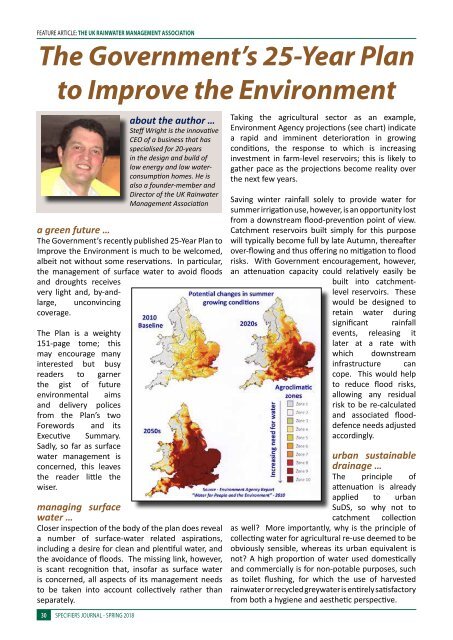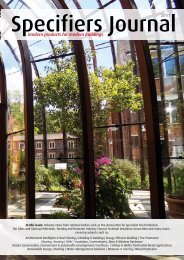ECOBuilder-Specifiers Journal spring2018
Create successful ePaper yourself
Turn your PDF publications into a flip-book with our unique Google optimized e-Paper software.
FEATURE ARTICLE: THE UK RAINWATER MANAGEMENT ASSOCIATION<br />
The Government’s 25-Year Plan<br />
to Improve the Environment<br />
a green future …<br />
The Government’s recently published 25-Year Plan to<br />
Improve the Environment is much to be welcomed,<br />
albeit not without some reservations. In particular,<br />
the management of surface water to avoid floods<br />
and droughts receives<br />
very light and, by-andlarge,<br />
unconvincing<br />
coverage.<br />
The Plan is a weighty<br />
151-page tome; this<br />
may encourage many<br />
interested but busy<br />
readers to garner<br />
the gist of future<br />
environmental aims<br />
and delivery polices<br />
from the Plan’s two<br />
Forewords and its<br />
Executive Summary.<br />
Sadly, so far as surface<br />
water management is<br />
concerned, this leaves<br />
the reader little the<br />
wiser.<br />
managing surface<br />
water …<br />
Closer inspection of the body of the plan does reveal<br />
a number of surface-water related aspirations,<br />
including a desire for clean and plentiful water, and<br />
the avoidance of floods. The missing link, however,<br />
is scant recognition that, insofar as surface water<br />
is concerned, all aspects of its management needs<br />
to be taken into account collectively rather than<br />
separately.<br />
30 SPECIFIERS JOURNAL - SPRING 2018<br />
about the author …<br />
Steff Wright is the innovative<br />
CEO of a business that has<br />
specialised for 20-years<br />
in the design and build of<br />
low energy and low waterconsumption<br />
homes. He is<br />
also a founder-member and<br />
Director of the UK Rainwater<br />
Management Association<br />
Taking the agricultural sector as an example,<br />
Environment Agency projections (see chart) indicate<br />
a rapid and imminent deterioration in growing<br />
conditions, the response to which is increasing<br />
investment in farm-level reservoirs; this is likely to<br />
gather pace as the projections become reality over<br />
the next few years.<br />
Saving winter rainfall solely to provide water for<br />
summer irrigation use, however, is an opportunity lost<br />
from a downstream flood-prevention point of view.<br />
Catchment reservoirs built simply for this purpose<br />
will typically become full by late Autumn, thereafter<br />
over-flowing and thus offering no mitigation to flood<br />
risks. With Government encouragement, however,<br />
an attenuation capacity could relatively easily be<br />
built into catchmentlevel<br />
reservoirs. These<br />
would be designed to<br />
retain water during<br />
significant rainfall<br />
events, releasing it<br />
later at a rate with<br />
which downstream<br />
infrastructure can<br />
cope. This would help<br />
to reduce flood risks,<br />
allowing any residual<br />
risk to be re-calculated<br />
and associated flooddefence<br />
needs adjusted<br />
accordingly.<br />
urban sustainable<br />
drainage …<br />
The principle of<br />
attenuation is already<br />
applied to urban<br />
SuDS, so why not to<br />
catchment collection<br />
as well? More importantly, why is the principle of<br />
collecting water for agricultural re-use deemed to be<br />
obviously sensible, whereas its urban equivalent is<br />
not? A high proportion of water used domestically<br />
and commercially is for non-potable purposes, such<br />
as toilet flushing, for which the use of harvested<br />
rainwater or recycled greywater is entirely satisfactory<br />
from both a hygiene and aesthetic perspective.







